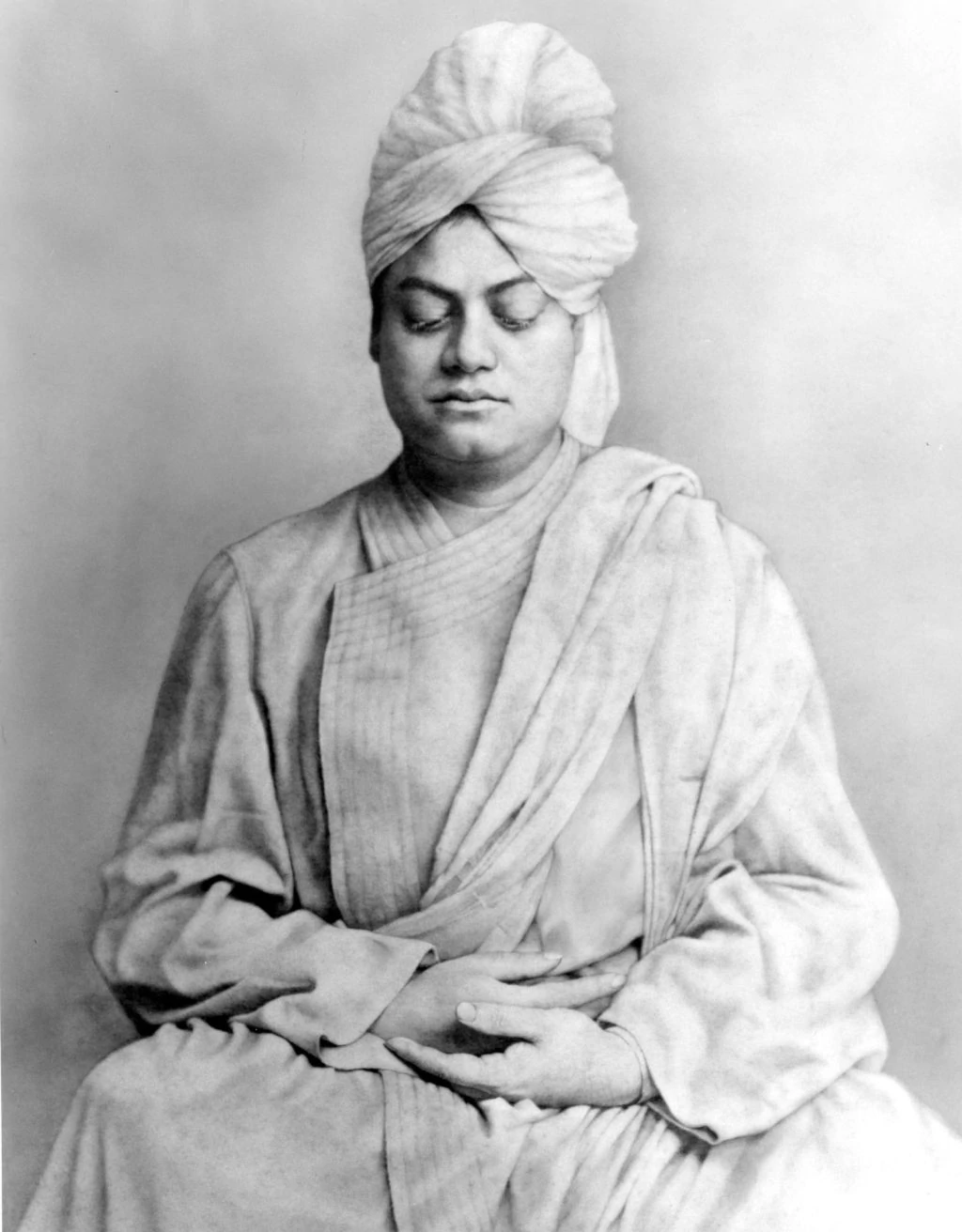Our Inspiration: Swami Vivekananda
"Swami Vivekananda, the embodiment of strength and wisdom, inspires us to strive for self-realization, the upliftment of society, and the realization of our infinite potential."

Swami Vivekananda
Swami Vivekananda, born Narendra Nath Datta on 12 January 1863, was raised in an affluent family in Kolkata. His father, Vishwanath Datta, was a successful attorney, and his mother, Bhuvaneshwari Devi, was a devout woman with a strong character. A gifted child, Narendra excelled in music, gymnastics, and academics. By the time he graduated from Calcutta University, he had amassed an extensive knowledge of various subjects, especially Western philosophy and history. Narendra also practiced meditation from an early age and was involved with the Brahmo Movement for a while.
With Sri Ramakrishna
At the threshold of his youth, Narendra faced a
spiritual crisis and questioned the existence of God. It was during this time that he first
heard of Sri Ramakrishna. In November 1881, Narendra visited the Kali Temple in Dakshineshwar to
meet Sri Ramakrishna and asked him directly, "Sir, have you seen God?" Without hesitation, Sri
Ramakrishna responded, "Yes, I have. I see Him as clearly as I see you, only in a much intenser
sense." This interaction removed all doubts from Narendra’s mind, and he became a frequent
visitor to Dakshineshwar, where he grew spiritually under Sri Ramakrishna’s guidance.
Difficult Situations
In 1884, Narendra’s father suddenly passed away,
leaving the family in financial distress. Narendra took on the responsibility of supporting his
mother and siblings. In the following year, Sri Ramakrishna was diagnosed with throat cancer.
During Sri Ramakrishna's final years, Narendra and his fellow disciples cared for him. Despite
their financial struggles, Narendra led the disciples, continuing the spiritual practices.
Beginnings of a Monastic Brotherhood
After Sri Ramakrishna’s passing in
August 1886, Narendra and his fellow disciples formed a monastic brotherhood in Baranagar, North
Kolkata. The monks took formal vows of renunciation, and Narendra adopted the name "Swami
Vivekananda" (though this name was later used more widely). They lived together in a dilapidated
building and followed the teachings of Sri Ramakrishna.
Awareness of Life’s Mission
After forming the brotherhood, Swamiji felt a
higher calling to spread the message of Sri Ramakrishna to the world. During his travels across
India, he was deeply moved by the poverty and backwardness of the masses. Swamiji recognized
that India’s decline stemmed from neglecting the masses, and he became determined to inspire
self-confidence in the people. He focused on the need for both secular education to improve
their economic conditions and spiritual teachings to strengthen their inner lives.
Need for an Organization
Swami Vivekananda realized that to implement his
vision, an efficient organization was necessary. This led him to found the Ramakrishna Mission,
an institution dedicated to spiritual and social service, which would combine education and
relief work to uplift the masses and women.
Decision to Attend the Parliament of Religions
In 1893, Swamiji decided to
attend the World’s Parliament of Religions in Chicago. This event allowed him to present his
Master's message to the world and seek financial help for his mission to uplift the masses. With
the support of his disciples and the Raja of Khetri, he embarked on the journey to the USA.
The Parliament of Religions and After
Swamiji’s speeches at the Parliament
of Religions in 1893 made him famous worldwide as an orator and messenger of Indian wisdom.
After the Parliament, he spent several years in the USA, spreading Vedanta and Sri Ramakrishna’s
teachings.
Awakening His Countrymen
Swami Vivekananda returned to India in 1897,
where he received an overwhelming welcome. He toured the country, delivering lectures to inspire
the people, focusing on the unification of Hinduism, the upliftment of the masses, and the
importance of practical Vedanta.
Founding of Ramakrishna Mission
On 1 May 1897, Swamiji founded the
Ramakrishna Mission, an organization dedicated to both the spiritual development and social
service, such as running hospitals, schools, and rural development centers. It would also engage
in relief and rehabilitation during natural disasters.
Belur Math
In 1898, Swami Vivekananda established the Ramakrishna Math at
Belur, a permanent headquarters for the monastic Order. He created a new model of monastic life,
emphasizing both personal spiritual development and social service, open to all without
distinction of race, religion, or caste.
Disciples
Swami Vivekananda had a significant influence on many in both
India and the West, some of whom became his devoted disciples. Margaret Noble (later Sister
Nivedita) was one of his key disciples, dedicating her life to educating girls in Kolkata.
Last Days
Swami Vivekananda's health deteriorated due to his incessant
work, and he passed away peacefully on 4 July 1902 at the age of 39. Before his death, he
expressed his intent to continue his mission even after leaving his mortal body, stating, “I
shall not cease to work. I shall inspire men everywhere until the whole world shall know that it
is one with God.”